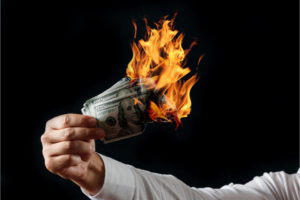Dear Survivor,
Your Survival Guy’s been watching lumber prices. I reported earlier this year that much of the increase was due to a bottleneck at sawmills. (There’s plenty of trees, just no excess capacity at the mills creating finished lumber.) Lumber futures reached a high of $1,711.20 per thousand board feet in May. Recently, July futures were down to $1,009.90, off 41% from the record high.
Ryan Dezember reports in the WSJ:
The rapid decline suggests a bubble that has burst and the question is how low lumber prices will fall. Even after tumbling, lumber futures remain nearly three times what is typical for this time of year. Lumber producers and traders expect that prices will remain relatively high due to the strong housing market, but that the supply bottlenecks and frenzied buying that characterized the economy’s reopening and sent prices to multiples of the old all-time highs are winding down.
If you want to know the real story behind the price drop, then simply follow the money as executives, in other words, insiders, sold stock suggesting peak lumber prices are in the rearview mirror, notes Ben Silverman of InsiderScore as reported by Dezember.
One reason for the selling is something we can all relate to from the last year of Covid: HOARDING. The big players who need lumber to build houses hoarded plenty of it. Now, as any rational operator does, they’re selling at the top, as those big buyers turn into SELLERS.
What does this mean for housing and the real estate market? Dezember continues:
“I don’t think $1,000 lumber prices are the new normal,” Devin Stockfish, chief executive of lumber producer Weyerhaeuser Co., told investors at a conference last week. “But that being said, when you think about the amount of housing that we’re going to have to build in the U.S. over the next three, five, 10 years, that’s just a significant amount of demand for wood products.”
At the same conference, executives from lumber producer PotlatchDeltic Corp. said they expect lumber to trade in a range of $700 to $800 through next year. That is still more than the pre-pandemic record of $639 and is based on their estimation of the price that mills in British Columbia need to break even sawing North America’s most-expensive logs. Prices below that could prompt mills in Canada to dial back output or shut down, which would eventually force prices higher to meet demand, they said.
Markets are emotionally charged beasts, absolutely impacted by the madness of crowds. Prices don’t need to be rational. Only a year ago we witnessed the run on toilet paper, an exodus from cities, and a new normal of hybrid work from home as FEAR set in and Americans looked for SAFE places to live and work.
If This Man Thinks Inflation is Back, Worry
You have been telling me about the inflation you’re seeing in your life. It’s not good. Inflation can throw all the calculations of a well-planned retirement into chaos. Even people who are still working need to readjust in the face of higher prices. When those old dollars you saved after working hard aren’t worth as much as you’d thought they’d be, life gets trickier.
Now, Roger Bootle, the man who officially declared inflation dead in a 1996 book title The Death of Inflation: Surviving and Thriving in the Zero Era (no relation to my monthly Survive & Thrive newsletter) thinks Americans should begin worrying about inflation again. Bloomberg‘s David Goodman writes:
A quarter of a century after declaring the death of inflation, Roger Bootle is seeing signs of its rebirth.
Pockets of price growth are emerging from the cost of used cars to lumber as the world starts to recover from the coronavirus pandemic. That’s pushed borrowing costs in financial markets to multi-year highs in major economies. While most central bankers seem content the higher gains are transitory, some economists are sounding the alarm.
Among them is Bootle, founder of Capital Economics and author of the 1996 book “The Death of Inflation: Surviving and Thriving in the Zero Era.” Back then, he argued decades of consistently high rates had come to an end.
While he doesn’t yet see a return to that era, in an interview with Bloomberg on June 2, Bootle argued the world is on the cusp of another turning point.
The conversation has been condensed and edited for clarity.
In the 1990s you identified the start of a new era for inflation. Do you think this is the start of another sea change?
Roger Bootle: “It is the start of a sea change, I have to say. That’s not to say that we’re going to go back to the strong inflationary conditions of the 70s and early 80s. But at the very least, I think we are at the end of the crypto-deflationary period that we’ve been in for the last few years.
“The danger of deflation has passed, and the risks have definitely tilted in the other direction. How high inflation will go, and for how long, that’s debatable. But I’m not in much doubt myself that there’s been a sea change.”
What are the broad trends coloring your outlook?
“You’ve got to draw a distinction between two key influences, and then policy on top, so three things to look at. The first is on the supply side — cost factors and institutional factors.
“Then, globalization, the collapse of trade unions and the intensification of competition — all those things, which I thought were, if you like, acting a bit like a reverse oil shock — presented a series of downward price shocks. There’s still room for some of those things to appear and continue. But the tide has turned, and the risks are very much the other way.”
Is there any particular areas of concern?
“If I had to put my money on a single factor that was going to push up costs in the years to come, I would say it was the environmental emphasis and in particular the drive towards net-zero. This is going to lead to a whole series of costs and price increases across the economy.
“The second element is demand. In the era before low inflation, it was common for policymakers and academics to completely ignore supply side institutional factors as being quite irrelevant — it’s all about money.
“When you look at the demand factors, it’s pretty striking. We’re entering in a period when demand is going to be strong. We’ve got this pent-up demand because of Covid. You’ve got people with lots of money.
Do you think that a degree of complacency is creeping in with policy makers?
“I’m not sure complacency is quite the right word. I think it’s over-optimism with regard to inflation, but on two counts. One that’s it’s not going to go up that much, at least not sustainably. And two, if it does, as and when they need to, they’re going to be able to contain it.
Don’t get complacent about inflation or your portfolio planning. Save until it hurts, because you might need every extra dollar if inflation kicks off in a big way. You should start early. Get started right after graduating. I tell you how in my free special report, How To Invest After Graduating College.
Timber!

By Kletr @ Shutterstock.com
Your Survival Guy’s on the pulp, I mean pulse. You know about the bubble that’s popped in lumber prices. That’s old news. It’s the same old story that goes like this: Government creates an incentive to grow trees on depleted farms in the south and boom, trees everywhere. The financial crisis hits, demand plummets, sawmills are shuttered. Then COVID, boom again, but not enough finished lumber. Prices go up, big owners of finished wood sell into the market, bubble deflates. Rinse and repeat.
Look, Your Survival Guy isn’t in the prediction business—it’s enough trying to figure out what’s already happened. But, hey, the American Dream is owning a home, and that dream is not gonna die, which is why another Wall Street firm plunked down $6 billion to buy thousands of single-family rental homes with an option to buy. The big winners in this scheme won’t be the married couples with two and a half kids and a dog.
Wall Street is giddy over carbon credits, where they get paid to clean their private jet wash. In other words, pay tree owners not to cut them down. Not a bad gig if you ask me. Paid not to work, what’s not to like? Sounds like a Biden plan.
California is on the leading edge of carbon credits—shocker—and I see this becoming a states’ rights issue. Another reason for you to become familiar with Your Survival Guy’s Super States study.
Do carbon credits even help the environment? According to one expert, the trees that are being sold as credits would have never been cut down, to begin with, while another feels the older growth will help states like California manage timber. Sounds like a red state owner’s manual where they actually manage timber—old growth doesn’t ignite like the tinder and brush littering California.
Heck, if I’m an owner in a red state and can get paid to sell to the government, reduce supply and increase prices down the road, I’m all in, but be warned, we’re in the early stages of this game, and Lucy’s holding the football.
The ones who tend to pay the price for these boondoggles are the ones putting out the fires, literally. Firemen in California pensions are at the mercy of the investment managers who flock to these carbon credit markets like the swallows of Capistrano. Do they make money? Who cares when they can hide behind the opaque performance and keep living the dream.
Inflation and Destruction of the U.S. Dollar University
With inflation running hot, team Biden is actually thinking about forgiving student debt. When you run out seven percent inflation (not impossible) for ten years, debt is half of what it was. Coincidence? Hardly.
While Biden ratchets up inflation to pacify the radical progressives and students who put him in office, the American middle class will suffer. Kristin Tate writes in The Hill:
The sharpest tax President Biden is levying upon Americans is one that was never passed by Congress, promised from the White House, or voted on by citizens at the ballot box. The invisible tax of rising inflation will do far more to harm working and middle-class Americans than Biden’s proposed tax hikes. The trillions of dollars in congressional spending and money printing from the Federal Reserve is already having a dramatic effect on the price of ordinary goods. Inflation has reached its highest point in years, and will likely reach the highest in two generations.
Over the past year, food prices are up 3.5 percent, with eggs and meat up by over 5 percent; gas is up 22 percent and is expected to get even higher by this summer; lumber is up 250 percent; new home prices are up $36,000, with overall housing up 11 percent; and new cars are up 9 percent, the highest in 68 years. In April, 13 percent of new car buyers paid more than the sticker price. Other goods — from household items, baby care and general merchandise — are already up between 5.2 and 7.2 percent from this time last year. The cost of eating out shot up by 3.7 percent over the past year, and some takeout specials such as chicken wings have nearly doubled. Coffee futures are up 24 percent since October. Even growing your own food has surged in price, with the cost of seeds and potted plants jumping by 10.5 percent.
Feeding the problem is the sharp price increase in commodities vital to our basic needs. Microchip prices are up by 25 percent over the last year, hiking the price of items from phones to televisions to car parts. Meanwhile, increased corn prices will further impact a variety of food products. Corn prices have nearly doubled since the start of the pandemic and reached a 13-year high. Along with corn, food prices are buoyed by a 59 percent increase in pork, 23 percent spike in soybean costs, and 21 percent increase in wheat prices. Whatever increase we’ve seen in grocery and restaurant bills will only accelerate as the trend continues.
Put it all together, and consumer prices are the highest they’ve been in eight and a half years. Economists now not only see the risk of inflation “higher than in the last two decades,” but the distinct risk of the Federal Reserve having to increase interest rates by the end of 2022.
The primary driver of the current inflation comes through money printing by the Federal Reserve. The Fed nearly doubled its bond purchases since the beginning of the pandemic, pumping almost $4 trillion into the economy. This is about as much as the Fed purchased between 2008 and 2014, during the worst of the Great Recession. From February 2020 to March 2021, the total of circulating cash, mutual funds and banking deposit money supply increased from $15.473 trillion to $19,896 trillion. The Fed effectively monetizes the federal government’s debt, creating both a cover for higher deficits and increasing the money supply further. From 2019 to now, the national debt jumped from just under 80 percent of gross domestic product to over 100 percent.
The second means of inflation comes through massive government spending. Between several “emergency” measures hastily passed under the guise of pandemic relief and President Biden’s massive new spending plans, we are looking at the potential for 1970s economic stagflation. Biden wants to spend nearly $2 trillion on a misleadingly-named “infrastructure” bill and $1.8 trillion in new social spending. Combined with the already-passed 2021 COVID-19 relief package, this spending will total $6 trillion — more than double the entire federal budget before the Great Recession. As if these large spending plans aren’t enough, the president requested a 16 percent increase in domestic spending in next year’s budget. Is he offsetting the increased social spending with cuts to the military? Nope — the proposed Pentagon budget is up by 1.5 percent.
Even worse, the government seems to be less than concerned about the possibility of stark inflation. Treasury Secretary Janet Yellen said just last week that she is not concerned about it. The White House says that any inflation seen will be mild and temporary.
All of Biden’s inflation could lead to the destruction of the dollar, loss of its status as the world’s reserve currency, and a bout of economic suffering the likes of which no American alive has endured.
Prepare yourself and your portfolio with an eye toward inflation and economic dislocation. I’m here to help if you need it.
Survive and Thrive this Month.
Warm regards,
E.J.,
“Your Survival Guy”
- If someone forwarded this to you, and you want to learn more about Your Survival Guy, read about me here.
- If you would like to contact me and receive a response, please email me at ejsmith@yoursurvivalguy.com.
- Would you like to receive an email alert letting you know when Survive and Thrive is published each month? You can subscribe to my free email here.
- You can also follow me on Twitter, Instagram, and Facebook.
P.S. Your Survival Guy is here to report that Walt Disney World is open for business. And if you’re in love with Star Wars, like my family is, then you need to check out Star Wars: Rise of the Resistance at Star Wars: Galaxy’s Edge inside Disney’s Hollywood Studios, where you feel like you’re in a galaxy far, far away…
But, before you go, there’s some groundwork that needs to be covered. First, you need a reservation for the days you wish to visit a Walt Disney World (WDW) park. As we started our planning, we looked at the WDW calendar and found reservations for Disney Hollywood Studios to be sold out. Then, a couple days later, Disney made more available, and we were able to book out our desired days.
Covid rules are being relaxed daily. But, if you’re planning on going, make the park reservations first, then get your park passes. Also, if you get a Hopper pass, which allows entry to the other three parks after 2pm, you need to arrive at the “reserved” park first.
If you want to experience Star Wars: Rise of the Resistance, you need to take an additional step by joining a virtual queue accessed via the My Disney Experience app. The queue opens at 7:00am. We were on the app at 6:45am, and as soon as the clock struck 7:00am we gained access to the virtual queue where you’re given instructions when to arrive at the attraction, which for us was around 11:30am (you have an hour window to arrive).
On day three, we visited Star Wars: Rise of the Resistance for a second time and, while in line, noticed the My Disney Experience app showing the Avatar ride (We love it! Our favorite! Do it!) over at Animal Kingdom had a 270-minute wait. We checked out Walt Disney News Today (WDNT) for the scoop. There’s a cottage industry of websites with up to the second reporting on all things Disney. Turns out there was a power outage at Animal Kingdom, which was the second one that week. When it was our turn to enter the Rise of the Resistance, we were told there was a service issue (power outage is my guess) and to come back when the attraction appeared again on the app, and we could use our pass to gain reentry to the front of the line.
How about those crowds? Civil, well-mannered, and everything you expect from Disney. There was no yelling. No fights in line. There aren’t many belligerents stumbling around when a couple beers costs twenty bucks. More updates? Fast Passes aren’t available because of Covid, but there’s a rumor about their imminent return, along with nightly fireworks in early July. Also, parks opened the gates a half hour before the reported opening times. Masks were “required” inside the attractions, but I just read the requirement has since been lifted. Like I said, things are fluid right now, and you need to keep checking on the rules. In October, Walt Disney World celebrates its 50-year anniversary and will pull out all the stops over the following 18-months.
My Disney experience? Well, you’re never too old to visit Disney. I remember like it was yesterday visiting for the first time with my sister and parents. I remember how excited my mom and dad were to take us there. I remember sitting with my dad on the skyway and my mom telling us about Walt Disney’s dream to build a clean, safe park he could visit with his young daughters. And now, I can’t believe my children are basically adults—life goes on. But to be able to go back to a place where you just enjoy being together? To me, that’s magical.


U.S. Secretary of State Hillary Rodham Clinton delivers remarks at the Opening Session of the U.S.-China Strategic and Economic Dialogue at the U.S. Department of Interior in Washington, D.C., on May 9, 2011. [State Department photo/ Public Domain]
In a leaked State Department cable from 2009, then-Secretary of State Hillary Clinton warned that the Wuhan Institute of Virology could lead to “biological weapons proliferation concern.”
The cable, obtained via Wikileaks, was sent from the State Department in June 2009 to all embassies in member nations ahead of the Australia Group plenary session in Paris, September 21-25, 2009. The Australia Group is an international export control forum organized to prevent the spread of technologies and research that could be used in chemical and biological weapons. All Five Eyes nations are members of the group, including the EU, India, Japan, and South Korea. China is not a member of the group.
The cable stated, “We believe it is important to focus on emerging chemical and biological technologies, trends in the trade of CBW-related goods and threats.”
When it came to France, Secretary Clinton’s cable noted:
“The U.S. believes participants would benefit from hearing about your experiences assisting China in setting up a Biosafety Level-4 (BSL-4) laboratory at the Wuhan Institute of Virology from the export control and intangible technology transfer perspectives. We are particularly interested to know how China plans to vet incoming foreign researchers from countries of biological weapons proliferation concern.”
More broadly on the question of China’s biological weapons program, Secretary Clinton’s cable noted:
“The U.S. believes AG members would be interested in any information you can share related to China and North Korea, specifically information related to:
- China’s Institutes of Biological Products (locations in Beijing and Wuhan), to include overhead imagery analysis, if possible.
- Your perceptions of the CBW proliferation activities by Chinese entities.
- Your perceptions of Chinese government efforts to enforce its export control rules.”

President Donald J. Trump and First Lady Melania Trump disembark Air Force One Wednesday, Aug. 7, 2019, at El Paso International Airport greeted by Texas Governor Greg Abbott, Senators John Cornyn and Ted Cruz, and El Paso Mayor Dee Margo. (Official White House Photo by Shealah Craighead)
P.P.P.S. In what Politico calls a “revolt against the new administration,” Texas Governor Greg Abbott has refused to accept the Biden administration’s radical left-wing agenda. Politico reports:
In the span of a week, Texas Gov. Greg Abbott has signed bills restricting the teaching of critical race theory and allowing Texans to carry handguns without a license. He’s preparing to order state lawmakers back into a special session to pass legislation restricting voting access, a GOP priority. And in the most pugilistic affront to President Joe Biden’s White House yet, he announced Texas will build its own border wall.
Less than six months into Biden’s presidency, Texas conservatives are in revolt against the new administration. And Abbott, the often overshadowed governor of the nation’s biggest red state, is emerging as an unlikely leader of the Biden resistance.
“We are the tip of the spear, we are on the front of the battle lines, no question,” said James Dickey, the former chair of the Texas Republican Party. “With the federal government entirely abdicating their responsibility, that leaves us on the border needing to take up the fight, and Governor Abbott is clearly doing that.”
In part, raising the Texas flag is a return to form for Abbott, who made a political career out of suing the Obama administration. As state attorney general, his posture toward Washington was so hostile that he said of his job in 2013, “I go into the office in the morning. I sue Barack Obama, and then I go home.”
Abbott and other governors like Ron DeSantis of Florida and Kristi Noem of South Dakota are leading the fight against the radical overreach of the Biden administration.
Texas has been gaining new residents as they flee California, and Abbott recently signed into law some strong protections for Texans’ Second Amendment rights.
States like Texas, Florida, and South Dakota lie within America’s growth corridors, where retirees can live in liberty, and businesses can pursue growth with fewer obstacles set in front of them by blue state governors gone wild.
Download this post as a PDF by clicking here.
E.J. Smith - Your Survival Guy
Latest posts by E.J. Smith - Your Survival Guy (see all)
- Rule #1: Don’t Lose Money - April 26, 2024
- How Investing in AI Speaks Volumes about You - April 26, 2024
- Microsoft Earnings Jump on AI - April 26, 2024
- Your Survival Guy Breaks Down Boxes, Do You? - April 25, 2024
- Oracle’s Vision for the Future—Larry Ellison Keynote - April 25, 2024



















